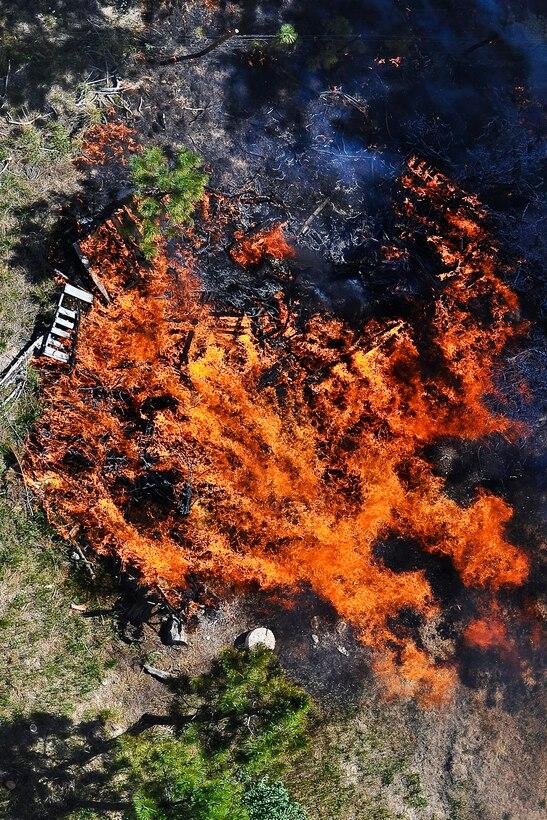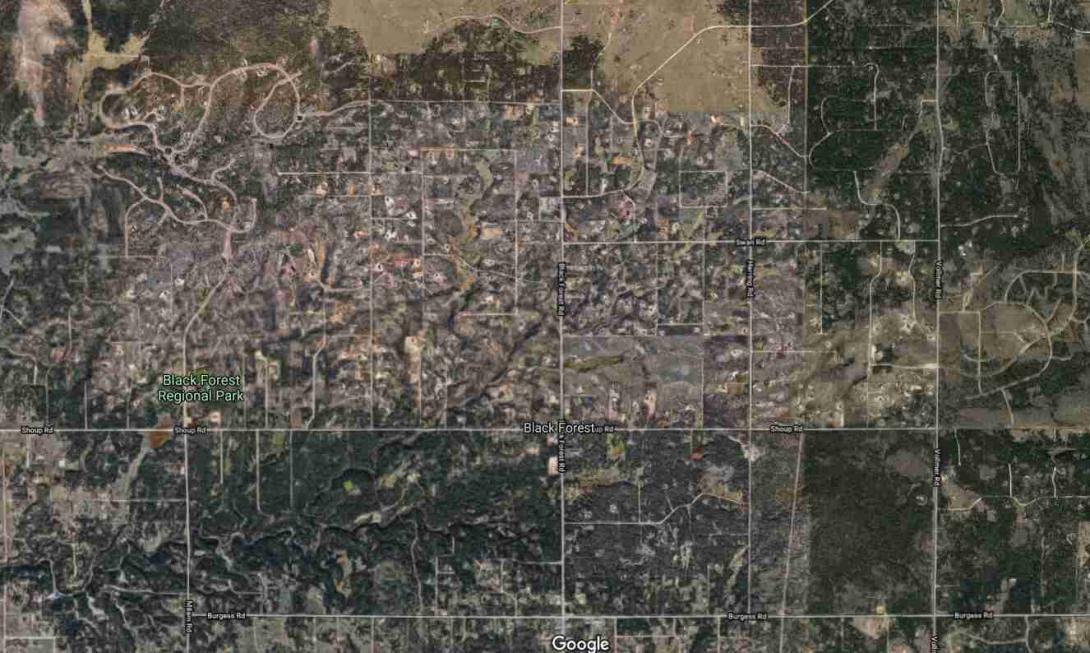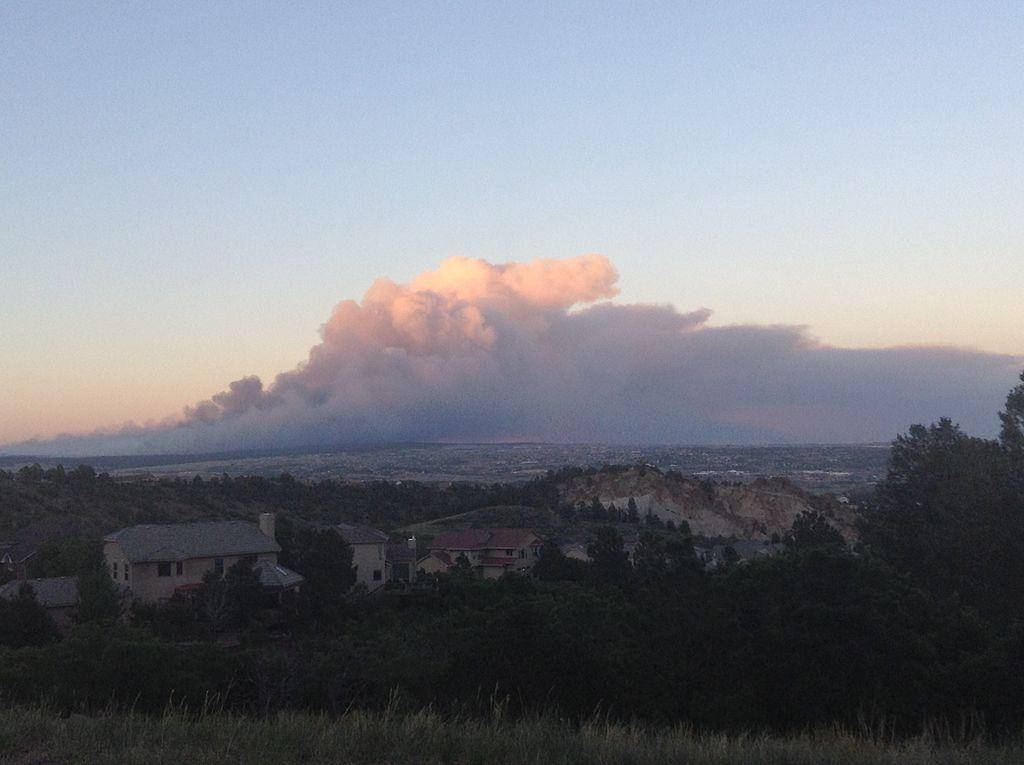Black Forest Fire
Full Article
The Black Forest Fire occurred in mid-June 2013 in a heavily populated woodland area northeast of Colorado Springs. Even though it was fully contained in just nine days, the fire’s proximity to neighborhoods made it the most destructive wildfire in state history: two people died and 486 houses were destroyed, amounting to about $300 million in damage. An investigation by the El Paso County Sheriff’s Office concluded that the fire was human caused but could not discover how it began.
Afterward, the recovery period was plagued by a feud between the El Paso County Sheriff and the Black Forest Fire chief, who sparred over the cause and handling of the fire. Frustrated Black Forest residents eventually filed a $60 million civil lawsuit against the fire district, county, and state, claiming the entire situation had been mishandled. Regardless of the controversy that followed it, the Black Forest Fire remains a warning of the dangers of building large communities in fire-prone landscapes.
2013 Fire Season
After a deadly 2012 fire season that saw June conflagrations near Fort Collins and Colorado Springs, Colorado’s Front Range braced for more record-breaking heat in the summer of 2013. On June 11, temperatures in Denver reached 100 degrees Fahrenheit, setting a record for the earliest arrival of triple-digit temperatures in the Mile High City. Already, dry and windy conditions had led to the ignition of several fires around the state, including one in Royal Gorge and another in Rocky Mountain National Park.
Black Forest Tinderbox
About sixty-five miles south of Denver, the Black Forest is composed of shrub oak and ponderosa pine groves atop the Palmer Divide, which separates the drainages of the South Platte and Arkansas Rivers. The divide’s high altitude (up to 7,700 feet) attracts moisture that allows for the growth of thick forests in an area otherwise dominated by treeless high plains. In the nineteenth century, the area was prized as a source of scarce timber for buildings in Denver and other cities.
Over the course of the twentieth century, the Black Forest area came to be appreciated for its unique scenery and proximity to urban centers such as Colorado Springs and Castle Rock. Developers recognized its potential for an increasingly wealthy class of Coloradans; by the early 2000s, the Black Forest was more exurb than natural area. Today, large houses are nestled throughout the ponderosas at an average price of about $1 million. Although scenic, the community’s natural setting puts it just a spark away from disaster during extremely hot and dry periods, like the one in June 2013.
Deadly Spark
The Black Forest Fire was reported at about 1 p.m. on June 11, 2013; it was later determined to have started in a wooded area near a subdivision. Driven by high winds and low moisture, the blaze quickly burned about sixty houses and spread over about 8,000 acres. Some 2,500 houses and buildings were immediately evacuated, but a week later authorities found that not everyone had made it out. Fifty-two-year-old Marc Allen Herklotz and his wife, fifty-year-old Robin Lauran Herklotz, died while trying to protect fire crews by removing ammunition and propane tanks from their property. Both were members of the Air Force Space Command.
By the time the Herklotzes’ fate was discovered, some 38,000 people had been evacuated—a number that soon reached a total of 41,000—and the Black Forest Fire was about 60 percent contained. On June 15, a fraction of evacuees was allowed to return to home.
Two days later, rain showers helped bring the fire to 75 percent containment, while El Paso County Sheriff Terry Maketa oversaw “an aggressive repopulation” of evacuated areas. Still, 4,100 residents remained in a mandatory evacuation zone, and the fire was burning on 14,280 acres. Intermittent rains allowed crews to achieve full containment by June 20.
Aftermath
As residents slowly returned to the community, many did not know whether their house had survived the blaze. Even if their house was still standing, residents faced other challenges: ash and debris contaminated more than 520 water wells, erosion threatened to degrade natural areas, and blackened limbs and charred trees could drop at any moment, posing additional danger to residents and property.
To help navigate these challenges, community members formed Black Forest Together, a nonprofit committed to recovery. The group offered demolition of blackened trees, reforestation services, and consultation for those affected by the fire. By 2016 volunteers with the group had logged more than 40,000 hours removing burned trees and shoring up erosion-prone areas. The Rocky Mountain Field Institute performed similar work. In 2017 the two groups—in partnership with the El Paso County Sheriff’s Office, Black Forest Fire District, and others—released a community wildfire-protection plan to prepare for future fires.
Controversy
In addition to cleaning up and repairing their neighborhoods, community members were subjected to a strange controversy regarding the investigation of the fire’s origin. First, Black Forest Fire Chief Bob Harvey announced that his investigators had determined the fire was started by arson. El Paso County sheriff Maketa denounced Harvey’s statement, saying his own ongoing investigation suggested the fire was human caused, but accidental.
Maketa also criticized Harvey’s handling of the fire, saying he should have turned control over to the sheriff sooner so that state resources could have been activated. In response, the Black Forest Fire District Board hired independent investigator Dave Fisher to address the controversy. By December 11, when the first Black Forest family moved into their rebuilt house, the investigation still had not concluded.
When Fisher’s report was finally released in March 2014, it defended the fire chief, concluding that “no one could have stopped this fire.” It further alleged that after Harvey turned over control of the fire to Maketa, crews focused on saving the house of a sheriff commander at the expense of other nearby residences. Maketa blasted the report as “slanderous” and said, “it needs to be burned.”
Even though he was cleared by the report, Harvey said he suffered from post-traumatic stress disorder and took an eleven-week leave of absence. The Fire District board subsequently announced his resignation in August 2014. The next year, Harvey sued the district as well as sheriff Maketa for $1 million, claiming that the district forced him to resign in retaliation for using benefits such as sick leave and vacation.
In September 2014, about sixty Black Forest residents filed a lawsuit alleging negligence on the part of the fire district, El Paso County, and the state. The suit sought $1 million for each plaintiff, but they did not hire an attorney. The case was dismissed in October because some of the plaintiffs decided to drop out of the lawsuit.
Later that year, the sheriff’s office finished its own investigation of the fire’s origins. The report concluded that the Black Forest Fire was human caused, but the extreme heat of the ignition area prevented investigators from being able to fully explain the cause. Meanwhile, Maketa resigned at the end of 2014 amid allegations of sexually harassing and emotionally abusing female subordinates.
Legacy
The location of the Black Forest Fire pointed to growing concerns about housing developments in fire-prone areas—places that experts refer to as the Wildland–Urban Interface (WUI). A 2018 study noted that since 1990, construction of new houses in the WUI across the nation increased by 41 percent, representing “the fastest-growing land use type” in the country. That same year, the Colorado State Forest Service found that 2.9 million Coloradans—almost half the state’s population—lived in the WUI.
In addition, more frequent wildfires are changing some Front Range forests into grassland, which swaps one kind of fuel for another. This is happening in the Black Forest, where in 2017 state forest officials noted that mitigation efforts such as clear-cutting had resulted in the growth of tall grasses that can also dry out and spark a conflagration.
The number of people living in fire-prone areas, combined with a warming climate that increases the likelihood of hot, dry weather, means that events like the Black Forest Fire will remain a threat into the future.



















